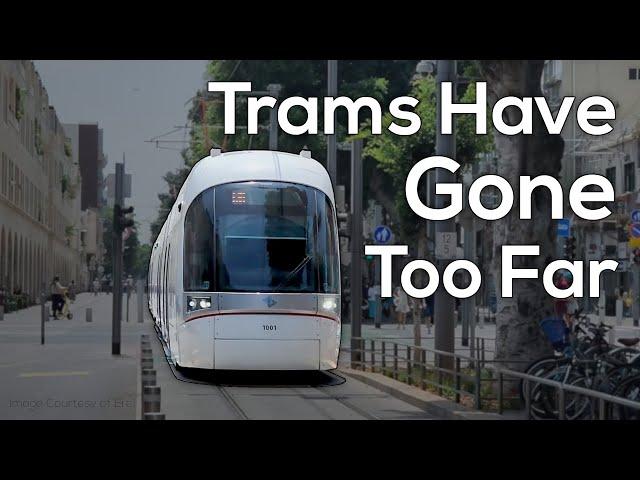Комментарии:

P.S.: Tel Aviv does have another service that runs on the Red Line to try and provide more service in the metro portion of the line - but this doesn’t fix the fundamental problem with the vehicles and dwell times!
Ответить
Anyone else get Sheldon vibes from this guy?
Ответить
You are so nerdy about public transport. Why don't you get a job at TTC that'd be your dream.
Ответить
I have never realised how many cities in America actually have trams. Many European cities have extensive puplic transport systems, integrating battery equiped electric busses. It works very well. There has to be a will to change the system from motorcar to a new system. Public transport has to be attractive for the public to use it.
Zürich in Switzerland is an almost perfect example. 🤗

the worst part of TLV red is the pants-on-head crazy station placement. if you get of the light rail at arlozorov central station and want to catch a train to haifa, you have to go up an escalator, up and elevator, through a tunnel, up stairs, across a busy highway*, through a *parking lot and then through ticketing and the rail station bridge to get to your connecting train
Ответить
Trams are very relevant in Poland. I can't agree that Trams aren't being pushed by buses, Trams are better than busses because they are avoiding traffic by being separated. My city is constantly creating new tram lines now they are planning to make one just near my house.
Ответить
The Bratisla tram system uses the new type of trams bjut about half of the fleet is still composed of the old high floor trams. So the whole system is a bit of a combination of everything you mentioned here. There are 4 lines and a 5th that only operates duting rushours with a few major interconnect points ( it think it's about 8) The number 4 line has 2 variations that alternate the old trams end of line is at Nove mesto stanica (train station) and the newever traims continue onwards towards Zlaté Piesky. Otberwise both of they ends of line on the other side is in Dubravka. All stops are somewhere around two minutes away from each other. The rails themself often go along the street or in the middle of it, sometimes being separated (also with the occasional car crossing) and sometimes being level with car traffic. There are a few combined tram and bus stops. And there is one where you walk on to the car road. Only the end of line stops and Trnavské Mýto (meeting point of numbers 4 and 9) offer any more hiding spots than you would see on a bus stop.
The trams also have really short intervarls, 4 minutes between the number 4 trams for example.

I don't think that modern trams can't fit any niche. For example in my town a mayor petitioned EuskoTren (the train operator of Euskera and developer of Bilbao's tram system) to create a modern tram system like the ones you mentioned in France, which is the type of tram they have on Bilbao, with the most efficient routes they could imagine. They drew two routes that might seem like few but obviously connected strategic points of a town that's smaller than even Bilbao. It would have costed 5000 million pesetas, which is about $35 million. The mayor said "Hell no!" and it made sense because we were a hella poor town back then. Now, fast forward to the 2000s, where Spain's property bubble had led to immense wealth and prosperity (that would later burst leaving us even poorer than before but that's another story), including in our town. The Ministry of Transportation presided by Francisco Alvarez Cascos (known womanizer) thought it was a great idea to improve public transportation in small areas of the country. And what did they do here? Revive the original tram plans? No! Instead they had the incredible idea of building a metro system. Entirely underground. And for a town of a measly 330000 people. What could possibly go wrong? Everything. Fast forward to today, almost 20 years later and we have no stations or rail sections opened. How much did it cost to build ghost tunnels, ghost rail lines and ghost stations? Now compared to this the $35 million was not so expensive: $450 million, more than 10x as much, to not build anything! It particularly touches my sensitive fiber because I live where "Christ lost his sandal" (Spanish for in the middle of nowhere), one of the areas that the tram would have served, in a route that connected it directly to the train station. Instead of taking one of those modern trams with great capacity, stability, and higher speed due to strategic dedicated right of way sections, I have to take an overcrowded, slow bus, that will have you constantly being hit by metallic elements whether you have to stand up, which is often, due to it's comically low stability. Although I try to avoid taking the bus when there is great weather (here it rains a lot, but thankfully is mostly during the afternoon), because I'm faster than the bus. Yes. A person by foot is faster than our buses. God, please end my suffering.
Ответить
FEWER doors, NOT LESS doors
Ответить
Trams are horrible. The power lines make cities ugly, they are noisy and tram track are outright dangerous
Ответить
My memory is so bad, I'd been here before. Still sounds really good.
The main idea I think is how gullible and corruptible politicians are - and how private companies want a profit - selling them and us a product that isn't fitting our needs.
Yes, 'low-floor trams' sound good to people who don't study transport and human conditions or needs. Also people don't understand why trams are placed in the centre of the road - and how they can be placed more like buses on the curb [without parking at tram stops of course[,
The reason is to do with the radius of rail track curves - and if we wish to turn a corner - which is more of concern when sharing roadways with cars etc. [Melbourne has a really odd system where for car drivers to turn right, we need to get into the left lane and wait for a special green light to turn in front of the tram line. But, you get used to that.]
Gold Coast trams use standard gauge track - and need more straight and dedicated road lanes than a European-type of old tram with metre gauge that can run up hills in narrow Lisbon streets.
In Lismore, I spoke with [now former] mayor, Isaac Smith of light rail into coastal Ballina town - using the left lane - like a bus. Queensland's 3'6" Cape gauge is better for street manoevering, and we just need safe ramps to a small platform - for wheelchairs and bicycles in the fornt section of the tram - while others can climb up above the bogie under floor height.

I do think aesthetics should play a significant role in making infrastructure-building decisions of any kind. Haven’t we had enough of utilitarian, soul crushing buildings, parks, avenues, etc?
Ответить
Craiova (South-West Romania).. we have a problem with our tram system (new trams and modernized infrastructure) because it blocks the city's traffic in the morning and afternoon (people going and coming from work). Basically, the tram lines (2 opposite lanes) should be better used for cars / buses lanes.
Ответить
Nice! But why do North-American trains, trams, tubes and light rail vehicles make a bell sound during driving? And why do most of them drive on diesel and less on electricity there (USA and Canada)?
Ответить
Someone else beat me to it. But give me a classic W Class Melbourne tram any day. They are beautiful and have stood the test of time.
Ответить
Noticed you have a lego crocodile in the background: please google bluebrixx swiss crocodile
Ответить
We have trams (aka "light rail") here on the Gold Coast in Australia, and they are fine for serving the narrow coastal strip where all the high-density towers by the beach are located. But the majority of public transport in this city is served by buses, as well as a heavy rail line which is really an inter-city line that extends north to Brisbane and interconnects to the tram line at one of the northern Gold Coast suburbs, Helensvale. They are currently working on extending the tram line further south from where it terminates in one of the highest density suburbs, Broadbeach, and a lot of residents in Palm Beach, a suburb even further south are protesting about future plans to run the tram line through their suburb. There is a lot of traffic disruption during the construction phase, and of course some car lanes are eliminated when it's finished as the tram doesn't just run in the street, it has its own dedicated lane which cars are not allowed to travel in. So yes, trams are a controversial subject in this city.
Ответить
I like trams but they are dangerous for bikes
Ответить
I am hurt by the lack of reference to the New Orleans streetcars. They're a little more decorative than truly useful these days, but some people do genuinely use them for commuting, especially if they live along St Charles or Canal and work downtown. Both of those streets have horrid congestion during peak hours, but the streetcars completely bypass that since they are separated from the cars
Ответить
Meanwhile sitting in the US saying "at least you guys are still allowed to have trams"
Ответить
.....buses for the most part still are dependent on fossil; fuel while trams are electrified.
Portland's streetcar lines are actually well utilised by commuters.

Its incredible. So many polite comments about how good trams are. I agree. But come on guys, this guy needs to be called out. Spouting ingnorant commentry on a system that works, people like, and helps. Not everything is about facist capitalism. The best in life is rarely delivered by optimum accountacy criteria or maximised profit. Can you imagine the backlash if a European went over to America and said "slower is better!!" "Imperfect is more beautiful"
Ответить
Melbourne in Australia uses trams all over, middle of the road trams, in fact I don't think they ever stopped using trams!
Ответить
Despite fitting so many examples of tram infrastructure footage, none of arguably the largest tram network in the world? Melbourne, Australia???
Ответить
Late to the party here, but I'd love a video on "what city X should have build and WHY, or city Y built this and why it's GOOD, and if you live in city type A, B, or C, what is best for you" so that I can be more informed about what my city should be moving towards.
Ответить
I think that, as usual, Warsaw transit strikes a nice middle ground. It uses tramways instead of cramming the streets, but it offers a decent level of interconnectedness. Additionally, the rails often function as dividers on major arterial roads, making use of what otherwise would have been dead space.
In the city centre, the tram is clearly modeled after the pre-existing street car design, with stops spread evenly and frequently. This allows commuters to skip the often-horrendous traffic, reducing frustration.
When you leave the city centre, trams smoothly transition into an “express lane” of sorts, with stops further away and tramways that usually run beside the road, facilitating faster speeds by smoothing out any curves.
Lately, there was a huge project to connect a district that has been a hotspot for high-middle class residential development, which decreased the load on the bus network that either way usually just got stuck in traffic.

Tram is a horizontal lift
Ответить
Yeah Sydney's light rail is trash and as a bonus they cut a lot of bus routes saying that the new trams would service those same areas (they do not) 😊
Ответить
Reece you should talk about Adelaide's Glenelg line.
Ответить
For those who want a good idea of legacy tram networks, have a look at Melbourne trams. Within the city, the trams run like a legacy tram network whilst in the suburbs, a lot of them run on their own tramway.
Ответить
I can't wait for robotics to develop cybernetic legs for the wheelchair bound so we dont have to build these horrible low floor designs.
Ответить
I love "Das Tram" in Zürich, Switzerland... I prefer them to busses. But they can become full, since there is a limit to how many articulated parts they have: notable example: 12 tram to Zürich airport, also that one has some timing issues to S-Bahn schedule, I have to sprint often from S14 to that tram at Wallisellen .. It has lot of stops, but also some accidents have happened and they are thinking about some airbag on the outside (not too jumpy..)
Ответить
we actualyl have a few trams systems here in australia, melbourne and sydney are 2 of em, but the one im more familiar with is the gold coast light rail, which has a stop at helensvale which is where the rest of the QR network starts (not actually its just the link point) and it then goes past a university and hospital and onto the gold coast city proper down to pacific fair shopping centre. the rail line at a certain point follows the road and goes through australia fair, and past surfers paradise. most the year its not too busy, but last couple years the trams are very packed like sardines, specifically at the end of the pacific airshow (great airshow btw), and theres talk about extending the line to the gold coast airport (bit of controversy lately due to buses being used at the moment)
Ответить
for the Calgary green line I feel like it would be more problematic for the north segment to have full sized trains since it would mean much more buying and demolishing houses and businesses, of course you could probably get away with full sized alongside Edmonton trail but the catchment area would be much weaker
Ответить
Stohlen land
Ответить
Americans will never experience double bendy bus
Ответить
I live in Oslo, and the traffic here is rather horrible at rush hour, like everyonewhere else. If I hop on a bus, that bus will have to wait for cars regardless of what you say. So I rather hop on a tram. They're enormously more comfortable compared to a bus bouncing here and there and they're faster. If Oslo were to replace its trams with buses, that'll mean it'll need hundreds of more of them, which a driver each, making it even more idiotic and expensive. Saying that trams have gone off the rails, is simply BS.
Ответить
One place that could (and should have) go tram is YRT, it was in their original plan for Viva Next but I think that plan got scrapped... They've spent all this money to design and build dedicated bus lanes yet busses seem to have more issues and less smooth of a ride than any TTC tram I've ever been on (excluding the real vintage units)
Ответить
There's no such thing as "tram too far".
The more trams, the better.

I think this time the Author goes a bit of the rails. The main advantage of a tram design is, exactly that it can run on a street, a tramway or in a tunnel. The design limitations in regards to doors and getting on and off is not that extrem as mentioned. Bad designs are just bad designs. You can have a tram were the buggies are were the cars connect and the rest of the floor is low in the other areas. Or you do not go for the low floor and have a level floor all the way. You can optimize the design and placement of the doors. Trams are as different as they can be.
A city were I think trams work very well, is Hannover, where they run on roads, tramways and in tunnels and work as tram, metro and light rail. They moved from former 2.35 m broad cars to 2.50 m. The old car got a bulge making then 2.5 m broad while they were still used. They have well distributed doors and are quite roomy. The big advantage is, how dense the net is.
There is also a S-Bahn in Hannover, but that runs on the mainline railway tracks.

Classic Street-Cars / Light Rail can still be found in Hong Kong where they are giant wooden boxes (2 floors) and go at normally 20kph
Ответить
What a horrible video.
It becomes very clear after a few minutes, that the author simply hates "trams". And that he then pulls up all sorts of idiotic pseudo arguments against them.
Horrible.

Trams are an out of date technology. You can build articulated trolley buses which are a third of the cost to do the same job. Where a higher passenger capacity is necessary then a conventional railway is the best solution.
Ответить
I think one of the purposes of Modern European Tramways is to reserve space for future metro planning and constructions. Land acquisition costs in cities would be much more likely to go up than to go down, and the city might just have enough money to build a tramline but have no hope to build a metro line in the future if the land acquisition process do not start right away. Therefore they build tramways so as to acquire lands needed for future metro projects while delivering some public transportation services with lighter capacity.
Ответить
Excellent information, well produced. Thank you. (jazz music sneaking in at the end was a neat eat touch.)
Ответить
Melbourne has the world’s largest tram network and it works brilliantly because the it resisted the trend in the ‘50s and 60s to succumb to the dominance of the car. Its trams are well integrated with trains and, where necessary, buses and keep thousands of cars and busses off the road during peaks because of their ability to move huge numbers of people. Their capacity is far, far greater than buses. . However, most cities are faced with having to reintroduce trams which is a far less ideal situation.
Ответить









![[RO-BOXING] ZWRBT OFFICIAL 2v2 Tournament - ZWGam [RO-BOXING] ZWRBT OFFICIAL 2v2 Tournament - ZWGam](https://rtube.cc/img/upload/Z3hicWZOdlU5R1I.jpg)
















